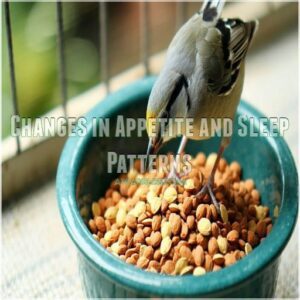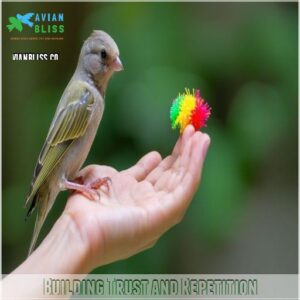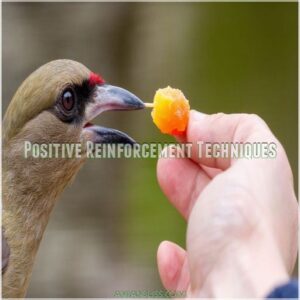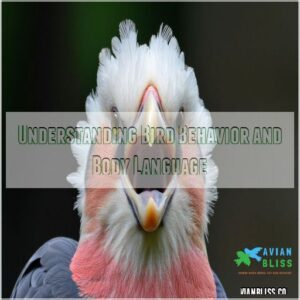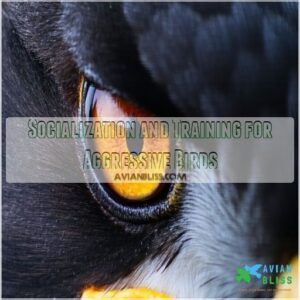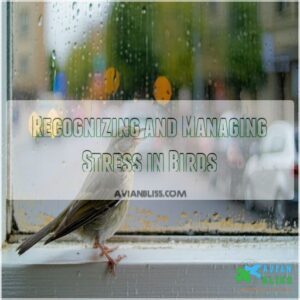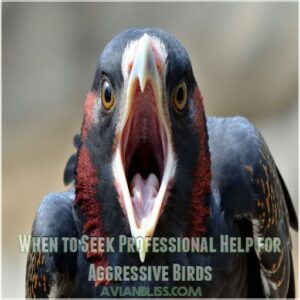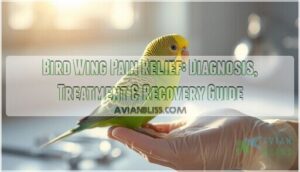This site is supported by our readers. We may earn a commission, at no cost to you, if you purchase through links.
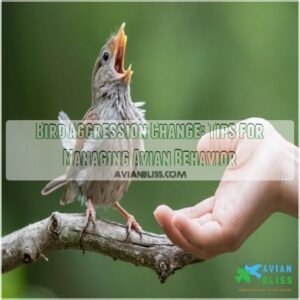
Imagine your feathered friend turning into a mini Hulk when their cage feels cramped or a new buddy moves in.
Hormonal shifts, particularly during breeding season, can turbocharge their territorial instincts, making them the real-life "Angry Birds!"
To manage this, make sure their space is adequate, and their routine consistent.
Pleasant interactions and mental stimulation work wonders too.
Avoid yelling—it’s as effective as shouting at a stubborn parrot to “chill.”
Discover more tips to tame that fiery spirit and foster harmony in your avian household.
Table Of Contents
- Key Takeaways
- Why Do Birds Become Aggressive
- Signs of Aggression in Birds
- How to Address Aggressive Behavior
- Creating a Safe and Calm Environment
- Understanding Bird Behavior and Body Language
- The Impact of Hormonal Changes on Bird Behavior
- Socialization and Training for Aggressive Birds
- Recognizing and Managing Stress in Birds
- When to Seek Professional Help for Aggressive Birds
- Preventing Aggression in Birds
- Frequently Asked Questions (FAQs)
- Do birds display aggressive behavior?
- Why do birds become aggressive during adolescence?
- Why is my older bird aggressive?
- What is bird behavior?
- Does aggression affect a bird’s survival?
- Why is bird behavior important?
- Why is my bird so aggressive all of a sudden?
- Why does my bird suddenly hate me?
- Why is my bird biting all of a sudden?
- Why are my birds suddenly fighting?
- Can diet affect a birds aggression level?
- How does cage size influence aggression?
- What role do toys play in reducing aggression?
- Are some bird species more prone to aggression?
- How can weather changes impact bird aggression?
- Conclusion
Key Takeaways
- You’ll find that bird aggression often stems from fear, hormonal changes, or territorial instincts. Understanding these triggers helps you manage and improve your bird’s behavior.
- Create a safe, stimulating environment with adequate space and mental enrichment to reduce stress and aggression. Engaging toys and varied interactions can prevent boredom-fueled frustration.
- Build trust through consistent, positive reinforcement techniques. Avoid yelling or physical punishment, which can increase stress and cement unwanted behaviors.
- Seek professional help if you notice severe aggression or changes in your bird’s appetite and health. Avian veterinarians and behaviorists can provide specialized guidance and solutions.
Why Do Birds Become Aggressive
When birds become aggressive, it’s often due to fear, hormonal changes, or even past traumas and neglect.
Understanding these behaviors can help you manage and improve your feathered friend’s well-being,
while staying mindful of their natural territorial instincts.
Fear and Lack of Socialization
Ever wonder why your bird suddenly turns aggressive? Fearful birds often haven’t had early socialization or trust-building experiences.
Ensuring a bird feels at home through safe environment creation is also important in addressing aggression. Hand-feeding, positive reinforcement, and environmental enrichment are key to ease their aggression.
Try these steps:
- Gradually introduce new people and experiences.
- Use treats to encourage interaction.
- Create a safe, comfortable environment.
Understanding these helps manage aggressive bird behavior.
Hormonal Changes and Adolescence
So, your feathered friend’s acting a little… feathery?
Hormonal changes, especially during adolescence, are a common cause of bird aggression.
Think of it like puberty, but with wings!
These hormonal fluctuations can trigger increased aggression, mating behaviors, and general mood swings.
Understanding these puberty effects helps you manage aggression triggers and prevent unwanted behaviors.
Patience and a consistent routine are key to getting through this phase; stress management is also vital.
Remember, this is temporary!
Past Trauma and Neglect
Hormonal fluctuations aren’t the only culprits; past trauma plays a big role in bird aggression.
If your bird lashes out, it might be reliving past neglect.
Help it heal with:
- Identifying signs of distress.
- Trust building through gentle interactions.
- Encouraging a recovery process with patience.
- Using coping mechanisms like environmental enrichment.
Understanding trauma aids in bird aggression management.
Territorial Instincts and Resource Competition
Birds, like warriors defending a castle, often exhibit territorial instincts and resource competition.
These natural behaviors can spark aggression in birds, especially around feeding stations or during mate selection.
Understanding this can reduce flare-ups.
Remember, they’re not being difficult—they’re just ensuring their survival.
Helping them navigate these instincts through bird behavior modification can foster harmony.
| Encounter | Behavior |
|---|---|
| Feeding | Dominance |
| Mates | Resource Guarding |
| Territory | Defense Actions |
Signs of Aggression in Birds
When you notice your bird suddenly lunging, vocalizing loudly, or plucking its feathers, it might be displaying signs of aggression.
Understanding these behaviors can help you address the root of the problem and maintain a calm household for both you and your feathered friend.
Body Language and Vocalizations
Recognizing bird aggression starts with tuning into their body language and vocalizations.
Notice the wing movements and shifts in head or body posture; these can signal unease.
Loud or harsh vocal outbursts might mean your feathered friend is on edge.
Watch for beak movements, too, as they can be telltale signs.
Understanding these cues helps manage and modify aggressive bird behavior.
Feather Plucking and Self-Mutilation
Feather plucking and self-mutilation can be signs of stress in birds, often rooted in boredom or anxiety.
Think of it as their desperate SOS for help.
As an owner, investigate potential causes—like lack of mental stimulation or health issues—and explore solutions like interactive toys or extra social time.
Understanding these behaviors is key for effective bird aggression prevention and treatment.
Biting and Attacking
When Polly decides to use her beak for more than cracking seeds, it’s a sign she might be stressed or defending her turf.
Understanding bird beak anatomy can help you manage this behavior change.
To prevent biting, focus on redirecting behavior with training and positive reinforcement.
Address stress triggers and make sure your feathered friend doesn’t associate hands with discomfort, avoiding bites.
Changes in Appetite and Sleep Patterns
Besides biting, watch for appetite changes.
A sudden drop in food intake (appetite loss, food refusal) is a red flag.
Changes in eating habits, like only eating seeds instead of pellets, can signal distress.
Sleep duration shifts—sleeping more or less than usual—are also important sleep changes to note.
These subtle shifts, alongside more obvious aggression symptoms, might point to underlying bird aggression causes.
Early detection can prevent bigger issues.
How to Address Aggressive Behavior
Tackling aggressive bird behavior requires a methodical approach focusing on building trust through consistent interaction and using positive reinforcement.
Avoid raising your voice or resorting to physical punishment, and instead, keep your feathered friend engaged with mental stimulation and regular exercise.
Building Trust and Repetition
Building trust with your bird takes patience and consistent routines.
Think of it like slowly introducing a new friend—every interaction is a step in the direction of bonding.
Engage with gentle words and calm movements, respecting their space.
Repetition is key; regular, positive interactions help melt away fear.
Over time, you’ll see how trust transforms bird aggression into a peaceful partnership.
Positive Reinforcement Techniques
Transform bird aggression with positive reinforcement.
Use treats, clicker training, and verbal praise to shape behavior.
Birds thrive on:
- Consistency: Create a predictable reward system.
- Timing: Reinforce immediately to link actions with outcomes.
- Variety: Mix rewards to keep motivation high.
- Patience: Understand parrot behavior change takes time.
Harnessing these instincts makes bird aggression training effective.
Avoiding Yelling and Physical Punishment
Switching gears from positive reinforcement, steer clear of yelling or using physical punishment with your bird.
These actions can amplify stress and cement unwanted behavior rather than curb it.
Imagine how a loud voice or force seems threatening from your bird’s perspective.
Instead, embrace patience and understanding, fostering a safe space that encourages trust and genuine behavior change.
Providing Mental Stimulation and Exercise
While yelling might seem tempting, keeping your cool is essential.
Instead, think of your bird’s mind as a puzzle needing solving.
Recognizing the triggers of aggressive parrot behavior such as cramped cages, loud noises, and disrupted routines can also help you address the root cause.
Bird toys and foraging games offer abundant mental stimulation.
Encourage interactive playtime and increase flight time for better pet bird behavior.
Use puzzle feeders to engage their instincts.
These activities help reduce bird aggression and provide effective bird aggression solutions.
Creating a Safe and Calm Environment
Creating a safe and calm environment for your bird is essential to minimizing aggression and stress.
Neutral locations for interaction are important.
Proper cage setup is also crucial.
Maintaining consistent socialization will help set the stage for a more peaceful avian companion.
Neutral Locations and Reduced Stress
During training, move your bird to a neutral location; this removes them from their territory, often promoting cooperation.
Think of it as a "bird-safe space" for Stress-free training, similar to how Sora’s AI revolutionizes video generation by transforming simple prompts into mesmerizing visuals, we can transform a chaotic environment into a peaceful one.
- Reduce distractions.
- Keep sessions short.
- Offer treats and praise.
A calm, quiet time in a safe haven helps reduce stress and strengthens your bond.
Proper Cage Size and Layout
Finding the right cage size can reduce stress and aggression in birds.
Make sure there’s ample space for stretching wings and placing perches at varying heights.
Adding toy variety and strategic hiding spots creates mental stimulation.
Place food bowls wisely to minimize territorial battles.
This setup isn’t just a home—it’s a training ground for fostering a calm, content bird.
Socialization and Interaction With Owners
Creating a strong bond with your bird can transform your relationship into a delightful partnership.
Here’s how you can deepen your connection:
- Offer treats during training sessions.
- Gently handle your pet to build trust.
- Use soothing words to calm jealousy.
- Encourage positive reinforcement for new tricks.
- Play interactive games to enhance bonding.
Special care fosters trust and companionship.
Minimizing Changes and Disruptions
Consistency is key, but life tosses changes your way. Keep disruptions minimal to build confidence in your feathered friends.
When travel or new birds arrive, use these strategies:
| Disruption Type | Solution |
|---|---|
| Cage changes | Add familiar items |
| New toys | Introduce gradually |
| Travel stress | Use soothing sounds |
| New birds | Slow introductions |
Ensure routine consistency sprouts confidence and flexibility.
Understanding Bird Behavior and Body Language
When you’re observing your bird, pay close attention to its posture and eye contact, as these can reveal subtle hints about its mood and intentions.
By understanding feather positioning, color changes, and the way your bird holds its beak and talons, you’ll be equipped to recognize both submissive and dominant behaviors in your feathered friend.
Posture and Eye Contact
Reading your bird’s posture and eye contact can be like cracking a secret code.
They communicate through:
- Direct stare: Often a warning sign of aggression.
- Averting gaze: Shows submission or appeasement.
- Wide eyes: Signals excitement or fear.
- Relaxed eyes: Indicates calmness and trust.
Understanding these body cues helps in managing aggressive bird behavior and improving training.
Feather Positioning and Color Changes
Observing your bird’s feather displays can reveal secrets about its mood.
Feather positioning acts like a mood ring—fluffed during molting patterns or smoothed to signal calm.
Changes in plumage can also be influenced by stress, which is why you should monitor your bird’s behavior and consider products related to bird color change stress.
Watch for color variations that might hint at stress indicators or even breeding signals.
Recognizing these changes helps you manage bird aggression, understanding parrot behavior, and addressing bird aggression symptoms effectively.
Beak and Talon Positions
Because a bird’s beak and talons are powerful tools, their position offers clues to its mood.
A relaxed bird will have a slightly open beak and relaxed talons.
Conversely, signs of aggression are:
- A tightly closed beak.
- Extended talons.
- A forward-leaning posture.
These are important signals to watch for to avoid bites and attacks and help you to manage bird aggression.
Recognizing Submissive and Dominant Behavior
Spotting dominant and submissive behavior in birds helps you understand their flock dynamics and social hierarchy.
Think of it as watching a soap opera, where some birds strut confidently (dominant) while others keep a low profile (submissive).
Understanding bird communication, including key bird visual cues, such as plumage coloration and displays, can also provide valuable insights into their behavior.
Recognize threat displays and passive gestures to manage bird aggression effectively, using behavior modification techniques for healthier bird aggression treatment strategies.
The Impact of Hormonal Changes on Bird Behavior
You might notice your bird acting like a moody teenager during adolescence when hormonal changes can trigger unexpected aggression.
Understanding these shifts, from breeding instincts to dominance adjustments, helps you manage your feathered friend’s behavior more effectively.
Adolescence and Maturity
As birds grow, adolescence brings hormonal shifts that can flip personalities like a switch.
Picture your feathered friend in the throes of a birdy teenage rebellion.
Hormone changes during puberty stages impact nesting instincts and social dynamics, leading to unexpected bird aggression against humans and other birds.
Your training revolves around patience, understanding, and adapting to these natural changes.
Breeding and Courtship Behaviors
Breeding and courtship behaviors in birds bring out fascinating hormone-driven dynamics.
During nesting season, you’ll witness:
- Elaborate mating rituals.
- Pair bonding that resembles your own romantic dinners.
- Species differences in how they express affection.
- Territoriality akin to guarding your favorite spot on the couch, which may lead to managing bird aggression.
- Hints of jealousy, adding drama to their avian soap operas.
Understanding these helps manage bird aggression effectively.
Changes in Dominance and Hierarchy
In the bird world, dominance and hierarchy shifts can ruffle feathers!
Age influences these changes, and during seasonal shifts, you might notice territorial disputes at the bird feeder.
When pair bonding kicks in, even the friendliest birds might display aggression against others.
It’s all about group dynamics; understanding these shifts helps manage bird aggression and keep the peace.
Effects of Hormonal Imbalances
Hormonal imbalances can turn your gentle bird into a feathery ball of fury.
During the breeding season, hormone levels may skyrocket, making your bird more territorial.
Dietary factors and stress management are key to soothing these tempests.
Consult an avian veterinarian for health concerns, as understanding bird psychology will help you navigate this hormonal roller coaster.
Socialization and Training for Aggressive Birds
Even the feistiest feathered friend can learn better manners; this section will guide you through proven methods like stick training and positive reinforcement to build trust and modify aggressive behaviors.
Desensitizing your bird to triggers and gradually introducing them to new experiences will help you foster a happier, less stressful relationship for both of you.
Stick Training and Target Training
When birds get grumpy, stick and target training can work wonders.
You guide your parrot with a stick, like a tiny maestro conducting an orchestra.
It’s all about positive reinforcement, making them comfortable without needing a touch.
Use these techniques to channel aggression into curiosity.
It’s safe, effective, and turns a potential nibble into a friendly step.
Desensitization and Counterconditioning
Building on stick training, desensitization takes center stage by gently exposing your bird to fear-inducing stimuli, rewarding calm responses.
Counterconditioning flips fear-based aggression on its head using positive reinforcement.
Imagine turning anxious chirps into melodies of trust. Through controlled sessions, your bird learns that the dreaded vacuum or stranger brings something good, reshaping its worldview with each interaction.
Gradual Exposure to New Environments
Gradually introducing your bird to new environments can be a game-changer in reducing aggression.
Start with small changes like rearranging cage toys or using a neutral location for training to prevent flooding with new stimuli.
Think of it like bird travel—short trips first, then longer ones.
This helps them adjust without triggering traumatic experiences, encouraging exploration and comfort.
Reward-Based Training Methods
Ever tried positive reinforcement training for parrots? It’s like magic! Use treats and praise to shape behavior. Here’s how:
- Start with clicker training – a click signals success.
- Reward immediately – timing is essential.
- Set treat schedules – consistency builds trust.
- Utilize training tools – sticks can guide without stress.
These methods can transform bird aggression into cooperation.
Recognizing and Managing Stress in Birds
Birds, like us, can feel stressed by unpredictable changes, loud noises, or even a lack of routine.
By learning to identify these stressors and creating a calm, enriching environment, you can greatly reduce your feathered friend’s anxiety and subsequent aggressive behavior.
Identifying Stressors and Triggers
Notice when your bird’s acting like a moody teenager?
Stressors like cage size, noise level, or even your new furry friend might be ruffling its feathers.
These changes can be sneakier than a cat in a birdhouse, leading to bird aggression against humans or other birds.
Keep an eye on diet changes or unexpected travel stress, helping manage aggressive bird behavior changes effectively.
Providing Calming Aids and Enrichment
Once you’ve pinpointed your bird’s stress triggers, it’s time to add some chill to their life. Think of it as creating a mini-spa for your feathered friend.
- Play calming music; many birds find it soothing.
- Offer a variety of bird toys to keep them mentally engaged.
- Natural perches provide comfort and improve foot health.
These simple steps can greatly reduce bird aggression with humans and foster a more peaceful environment.
Reducing Noise and Visual Stimulation
Quiet Zones in your bird’s environment reduce stress by minimizing Sensory Overload.
Designate bird-safe spaces with calming decor and limit Visual Clutter.
Here’s a quick guide:
| Environment | Action | Benefit |
|---|---|---|
| Living Room | Use curtains to dampen noise | Reduces distractions |
| Cage Area | Add natural, subtle colors | Calms the bird |
| Play Zone | Limit bright objects | Lowers stress |
| Window Spots | Hang blinds or sheer curtains | Soothes nerves |
| Sleeping Area | Make sure there’s dim, soothing lighting | Promotes relaxation |
Creating a Predictable Routine
Think of your bird’s routine as its daily symphony.
Regular feeding times, a consistent playtime routine, and predictable sleep schedules can build confidence.
Frequent cage cleaning keeps their environment fresh, while maintaining a travel schedule when necessary aids in stability.
A set routine isn’t just about order; it’s a pillar of parrot behavior that comforts and soothes their souls.
When to Seek Professional Help for Aggressive Birds
If your feathered friend’s aggressive behavior starts resembling a Hitchcock film, it might be time to call in the experts.
Consulting with an avian veterinarian or behaviorist can address severe aggression, changes in health, or ineffective training, ensuring your bird gets the support it needs.
Signs of Severe Aggression and Fear
Spotting severe aggression and fear in birds ain’t just for the birds. Watch out for extreme behaviors like feather plucking, self-harm, and biting: They may bite due to fear, stress, or a misunderstanding of communication, so it’s important to understand bird biting behavior to address the root cause.
- Sudden lunges that show fear-based aggression.
- Unsettled sleep as they perch with one eye open.
- Food refusal without apparent reason.
These signs suggest it’s high time to get professional help for handling these problems.
Changes in Appetite and Health
Notice any weight loss, feather loss, or food refusal?
These can be illness signs pointing to parrot behavior problems and challenges.
Digestive issues or other health changes might signal stress or aggression knocking on your bird’s door.
Keep an eye out for these hints to safeguard your parrot’s wellbeing, and when in doubt, seek professional help.
Ineffective Training Methods
Training a bird can be tricky.
If ineffective methods like punishment-based, fear-based, or inconsistent training are used, problems may persist.
Watch out for:
- Punishment-based training: Often leads to fear and stress.
- Inconsistent training: Confuses your bird.
- Lack of positive reinforcement: Missed chances for rewards.
- Poor communication: Misunderstandings and setbacks.
Consultation With Avian Veterinarians and Behaviorists
Sometimes, despite your best efforts, you might need extra help.
Avian vets can rule out underlying health issues contributing to your bird’s aggression.
Behaviorists offer specialized guidance.
| Professional | Expertise | Benefits |
|---|---|---|
| Avian Veterinarian | Bird health, physical causes of aggression | Diagnoses medical conditions, provides referrals |
| Parrot Behavior Consultant | Avian behavior, behavior modification | Develops specific treatment plans, ethical training |
| Certified Avian Trainer | Parrot training, avian behavior | Offers practical, effective behavior solutions |
Preventing Aggression in Birds
Preventing aggression in birds starts with early socialization and training to build trust and familiarity.
Stimulation is also key to reducing stress and keeping birds mentally engaged.
Make sure your feathered friend has adequate space.
Early Socialization and Training
Early socialization is your ticket to a well-adjusted feathery friend.
Hand-feeding a young bird fosters trust and bonding, making parrot behavior manageable.
Imagine your bird as a blank slate—every interaction scribes a lesson.
Use positive reinforcement and consistency to help shape their future.
Parrot training now minimizes bird aggression later, crafting a companion you’ll love having around.
Providing Adequate Space and Stimulation
To keep bird aggression at bay, make sure they’ve adequate cage size and ample enrichment toys.
Think of your bird’s habitat like a playground, where play time and foraging opportunities boost mental stimulation.
You can find a variety of these stimulating activities and accessories through online stores offering bird enrichment toys.
As confidence-building is essential, don’t overwork them. Rotate toys to prevent territory boredom and keep training playful.
This approach nurtures well-adjusted feathered friends.
Avoiding Pun
Birds need space to thrive, but when faced with aggression, avoid punishment.
Instead, focus on these positive alternatives:
- Offer Rewards: Encourage good behavior with treats.
- Use Positive Methods: Reinforce calm interactions.
- Implement Gentle Training Techniques: Build trust gradually.
- Understand Bird Psychology: Recognize triggers to prevent aggression.
These strategies enhance bird training practices and solutions.
Frequently Asked Questions (FAQs)
Do birds display aggressive behavior?
Yes, many bird species show aggression. It’s often about territory, food, or mating. Think of it like a neighborhood squabble—sometimes it’s just a peck, sometimes a full-blown fight.
Why do birds become aggressive during adolescence?
Think of adolescence in birds like a wild rollercoaster ride – hormones are raging, emotions are running high, and they’re still figuring out who they are.
leading to aggressive outbursts as they navigate this tumultuous stage.
Why is my older bird aggressive?
Your older bird might be aggressive due to past mistreatment, territorial behavior, or lack of socialization.
Try neutral territory training, gentle handling, and using treats to build trust.
Consistency and patience are key to reducing aggression.
What is bird behavior?
Bird behavior can be surprisingly complex.
From intricate social hierarchies to unique communication styles, each species exhibits distinct patterns.
Understanding these behaviors helps you connect with birds, revealing their fascinating world and offering insights into their daily lives.
Does aggression affect a bird’s survival?
Aggression in birds can impact survival by influencing access to food and mates, and exposing them to greater predation risks.
Balancing assertiveness for resources with caution is key for a bird’s survival in its natural environment.
Why is bird behavior important?
Understanding bird behavior is essential because it helps maintain their stress-free environment and promotes healthier interactions with humans and other birds.
Recognizing behavioral cues enhances care, ensuring happier, well-adjusted pet and wild birds.
Why is my bird so aggressive all of a sudden?
Is your feathered friend acting out?
Sudden aggression might stem from hormonal shifts, especially during adolescence.
It could also signal underlying health issues or unmet needs.
Consult an avian vet to rule out medical causes and discuss behavioral strategies.
Why does my bird suddenly hate me?
Your bird might suddenly dislike you due to hormonal changes, jealousy, or stress from environmental shifts.
Consider its recent experiences or interactions and make sure to use consistent, gentle handling.
Gradual, positive reinforcement helps rebuild trust and comfort.
Why is my bird biting all of a sudden?
Sudden bird biting might link to hormonal changes, lack of socialization, or fear.
Adolescence can spike aggression, just like teenagers acting out.
Try careful training, patience, and offering treats to rebuild trust and calm your feathered friend.
Why are my birds suddenly fighting?
Birds may suddenly start fighting due to hormonal changes, territorial disputes, or stress from environmental shifts.
Observe their interactions closely, offer separate spaces, and enhance enrichment activities to ease tensions and promote peace.
Can diet affect a birds aggression level?
A bird’s diet can influence aggression.
Nutrient imbalances, like too much protein or insufficient vitamins, sometimes heighten irritability.
Provide a balanced diet rich in fruits, vegetables, and seeds to help maintain a calmer demeanor.
How does cage size influence aggression?
Imagine a cramped studio apartment; now picture your bird squeezed into a small cage.
Limited space can heighten aggression as birds struggle with movement and enrichment, leading to irritability and territorial behavior.
Opt for larger enclosures.
What role do toys play in reducing aggression?
Providing your bird with engaging toys can greatly reduce aggression.
Enrichment keeps them busy, preventing boredom-fueled frustration.
Think of it as keeping them mentally stimulated, like giving a kid a fun project to avoid mischief.
Are some bird species more prone to aggression?
Certain bird species, like Amazons and macaws, can exhibit more aggression due to their natural behaviors and social structures.
Understanding the specific needs of each species and providing proper socialization can help mitigate these tendencies.
How can weather changes impact bird aggression?
When storms roll in or temperature swings rock your world, birds can get ruffled and aggressive.
Sudden weather shifts stress them out, heighten territorial disputes, and disrupt feeding, especially during breeding seasons when they’re extra protective.
Conclusion
Surprisingly, addressing bird aggression change isn’t as challenging as it seems.
By understanding the reasons behind your bird’s behavior—like fear, hormonal shifts, or territorial instincts—you’ll be better equipped to manage it.
Create a safe, stimulating environment, employ positive reinforcement, and focus on consistent socialization and training techniques.
If you notice severe aggression or health changes, consult an avian vet.
With patience and understanding, you can transform your home into a harmonious place for both you and your feathered friend.





